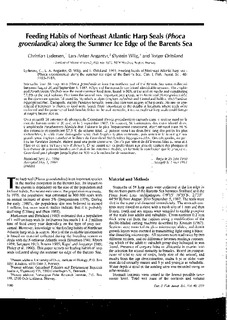| dc.contributor.author | Lydersen, Christian | |
| dc.contributor.author | Angantyr, Lars Anker | |
| dc.contributor.author | Wiig, Øystein | |
| dc.contributor.author | Øritsland, Torger | |
| dc.date.accessioned | 2008-07-15T12:47:18Z | |
| dc.date.issued | 1991 | |
| dc.identifier.issn | 0706-652x | |
| dc.identifier.uri | http://hdl.handle.net/11250/108098 | |
| dc.description.abstract | Stomachs from 58 harp seals (Phoca groenlandica) from the northern part of the Barents Sea were collected between August 20 and September 5, 1987. Fifty-six of the stomachs contained identifiable remains. The amphipod Parathemisto libellula was the most common food item, found in 98% of the seal stomachs and constituting 57.9% of the total volume. Fish were the second most important prey group, with Arctic cod (Boreogadus saida) as the dominant species followed by Nybelin's sculpin (Triglops nybelini) and Greenland halibut (Reinhardtius hippoglossoides). Decapods, mainly Pandalus borealis, were also common as prey of harp seals. No sex- or agerelated differences in choice of food were found. From knowledge of the depths at locations where seals were collected and the presence of fresh benthic fishes in the seal stomachs, it is assumed that harp seals could forage at depths below 300 m. | en |
| dc.format.extent | 730181 bytes | |
| dc.format.mimetype | application/pdf | |
| dc.language.iso | eng | en |
| dc.publisher | National research council of Canada | en |
| dc.title | Feeding habits of northeast atlantic Harp seal (Phoca groenlandica) along the Summer Ice Edge of the Barents Sea | en |
| dc.type | Journal article | en |
| dc.type | Peer reviewed | en |
| dc.source.pagenumber | 2180-2183 | en |
| dc.source.volume | 48 | en |
| dc.source.journal | Canadian Journal of Fisheries and Aquatic Sciences | en |
| dc.source.issue | 11 | en |
| dc.identifier.doi | http://dx.doi.org/10.1139/f91-257 | |
